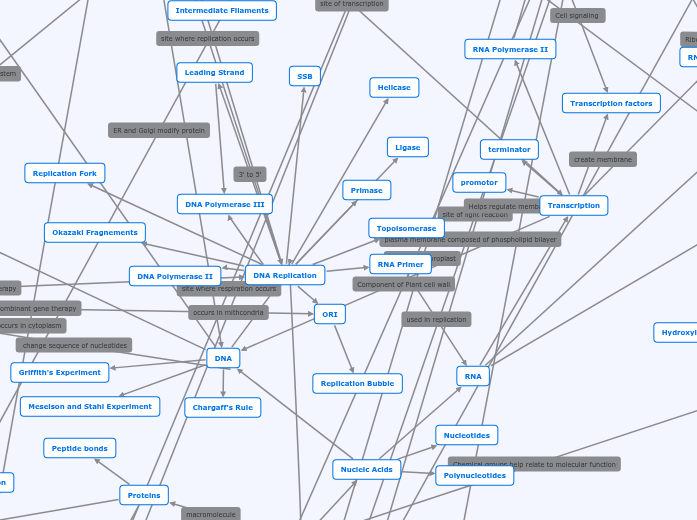The Molecules of Life
-Alexis and Sophia Concept Map
Carbohydrates
Monosaccharides
Glucose
Cellular Respiration
Glycolysis
Calvin Cycle
electron transport chain
Photosynthesis
light reaction
non-cyclic electron flow
NADPH
Dark reacction
Calvin Cycle
Cyclic electron flow
ATP
Polysaccharides
Cellulose
Peptidoglycan
Lipids
Phospholipids
Steroids
Cholesterol
Nucleic Acids
DNA
Meselson and Stahl Experiment
Griffith's Experiment
Chargaff's Rule
Mutations
Silent Mutation
Frameshift Mutation
Missense Mutation
Nonsense Mutation
Cloning
Reproductive Cloning
Dolly
Molecular Cloning
Recombinant Gene Therapy
bacterial cells
plasmid
Cell Cycle
Mitosis
Interphase
G1
G2
S Phase
Sister cromatids
M Phase
Prophase
Prometaphase
Metaphase
Anaphase
Telophase
Cytokinesis
diploid cells
2 daughter cells
Meiosis
Meiosis I
Interphase
Homologous chromosomes
haploid cells
crossing over
Meiosis II
sister chromatids
4 daughter cells
RNA
Transcription
Transcription factors
promotor
terminator
RNA Polymerase II
Eukaryotes
Membrane bound organelles
Nucleus
Nuclear Envelope
Nucleolus
Endomembrane system
Rough ER
Smooth ER
Golgi Apparatus
Mitochondria
Lysosome
Centrosomes
Flagellum
Cytoskeleton
Microfilaments
Intermediate Filaments
Microtubules
Peroxisomes
Plasma Membrane
Phospholipid bilayer
Amphipathic
Hydrophobic
Hydrophilic
Vacuole
Plasmodesmada
Chloroplasts
Chlorophyll
Stomata
Granum
Thylakoid
thylakoid membrane
Cell wall
cytoplasm
RNA Polymerase
Prokaryotes
Nonmembrane bound organelles
Ribosomes
Translation
Codon
Anticodon
Start codon
Stop codon
tRNA
aminoacyl tRNA synthase
peptidyl transferase
5' to 3'
RNA Processing
Gene splicing
Pre mRNA
5' cap
3' tail
spliceosome
Nucleotides
Polynucleotides
DNA Replication
DNA Polymerase II
DNA Polymerase III
SSB
Helicase
Ligase
Primase
Topoisomerase
ORI
Replication Bubble
Okazaki Fragnements
Replication Fork
Leading Strand
RNA Primer
Proteins
Protein Structure
Protein Modification
Amino acids
Nonpolar side chain(hydrophobic)
Polar side chain(hydrophilic)
Acidic
Basic
Peptide bonds
Large biological molecules composed of Organic molecules (CHONSP)
Chemical bonds hold atoms together
electron configuration
Valence electrons
Electronegativity
Ionic Bonds
- transfer of electrons
Inorganic Molecules
Covalent Bonds
- sharing of electrons
Polarity = results from differing electronegativities
Polar
Hydrogen Bonds = intermolecular forces that occur between Hydrogen and Nitrogen, Oxygen, or Fluorine
Water and its Properties
Cohesion
Adhesion
Surface Tension
Moderation of Temperature
Evaporative cooling
High Heat of Vaporization
Expansion upon freezing
Versatility as a solvent
Polar Covalent Bonds
- unequal SHARING of electrons
Nonpolar
Nonpolar Covalent Bonds
- equal SHARING of electrons
Van Der Waal Interactions
Hydrophobic interactions
Chemical groups
Hydroxyl (-OH)
Carboxyl (-COOH)
Carbonyl (>C=O)
Amino group (-NH2)
Sulfhydroxyl group (-SH)
Phosphate group (-OPO3^2-)
Methyl group (NONPOLAR)
Miller Urey Experiment
